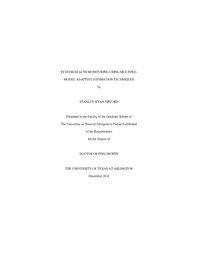
ATTENTION: The works hosted here are being migrated to a new repository that will consolidate resources, improve discoverability, and better show UTA's research impact on the global community. We will update authors as the migration progresses. Please see MavMatrix for more information.
Show simple item record
| dc.contributor.advisor | Subbarao, Kamesh | |
| dc.creator | Sifford, Stanley Ryan | |
| dc.date.accessioned | 2017-02-14T16:48:46Z | |
| dc.date.available | 2017-02-14T16:48:46Z | |
| dc.date.created | 2016-12 | |
| dc.date.issued | 2016-12-22 | |
| dc.date.submitted | December 2016 | |
| dc.identifier.uri | http://hdl.handle.net/10106/26445 | |
| dc.description.abstract | Monitoring system health for fault detection and diagnosis by tracking system parameters concurrently with state estimates is approached using a new multiple-model adaptive estimation (MMAE) method. This novel method is called GRid-based Adaptive Parameter Estimation (GRAPE). GRAPE expands existing MMAE methods by using new techniques to sample the parameter space. GRAPE expands on MMAE with the hypothesis that sample models can be applied and resampled without relying on a predefined set of models. GRAPE is initially implemented in a linear framework using Kalman filter models. A more generalized GRAPE formulation is presented using extended Kalman filter (EKF) models to represent nonlinear systems. GRAPE can handle both time invariant and time varying systems as it is designed to track parameter changes.
Two techniques are presented to generate parameter samples for the parallel filter models. The first approach is called selected grid-based stratification (SGBS). SGBS divides the parameter space into equally spaced strata. The second approach uses Latin Hypercube Sampling (LHS) to determine the parameter locations and minimize the total number of required models. LHS is particularly useful when the parameter dimensions grow. Adding more parameters does not require the model count to increase for LHS. Each resample is independent of the prior sample set other than the location of the parameter estimate. SGBS and LHS can be used for both the initial sample and subsequent resamples. Furthermore, resamples are not required to use the same technique. Both techniques are demonstrated for both linear and nonlinear frameworks.
The GRAPE framework further formalizes the parameter tracking process through a general approach for nonlinear systems. These additional methods allow GRAPE to either narrow the focus to converged values within a parameter range or expand the range in the appropriate direction to track the parameters outside the current parameter range boundary. Customizable rules define the specific resample behavior when the GRAPE parameter estimates converge. Convergence itself is determined from the derivatives of the parameter estimates using a simple moving average window to filter out noise. The system can be tuned to match the desired performance goals by making adjustments to parameters such as the sample size, convergence criteria, resample criteria, initial sampling method, resampling method, confidence in prior sample covariances, sample delay, and others. | |
| dc.format.mimetype | application/pdf | |
| dc.language.iso | en_US | |
| dc.subject | Concurrent state and parameter estimates | |
| dc.subject | Grid-based Adaptive Parameter Estimation (GRAPE) | |
| dc.subject | Multiple-model adaptive estimation (MMAE) | |
| dc.subject | Fault detection and diagnosis (FDD) | |
| dc.subject | Selected grid-based sampling (SGBS) | |
| dc.subject | Latin Hypercube Sampling (LHS) | |
| dc.subject | Extended Kalman Filter | |
| dc.subject | Independently resampled hypothesis models | |
| dc.title | SYSTEM HEALTH MONITORING USING MULTIPLE-MODEL ADAPTIVE ESTIMATION TECHNIQUES | |
| dc.type | Thesis | |
| dc.degree.department | Mechanical and Aerospace Engineering | |
| dc.degree.name | Doctor of Philosophy in Mechanical Engineering | |
| dc.date.updated | 2017-02-14T16:48:46Z | |
| thesis.degree.department | Mechanical and Aerospace Engineering | |
| thesis.degree.grantor | The University of Texas at Arlington | |
| thesis.degree.level | Doctoral | |
| thesis.degree.name | Doctor of Philosophy in Mechanical Engineering | |
| dc.type.material | text | |
| dc.creator.orcid | 0000-0003-0706-5707 | |
Files in this item
- Name:
- SIFFORD-DISSERTATION-2016.pdf
- Size:
- 4.354Mb
- Format:
- PDF
This item appears in the following Collection(s)
Show simple item record


